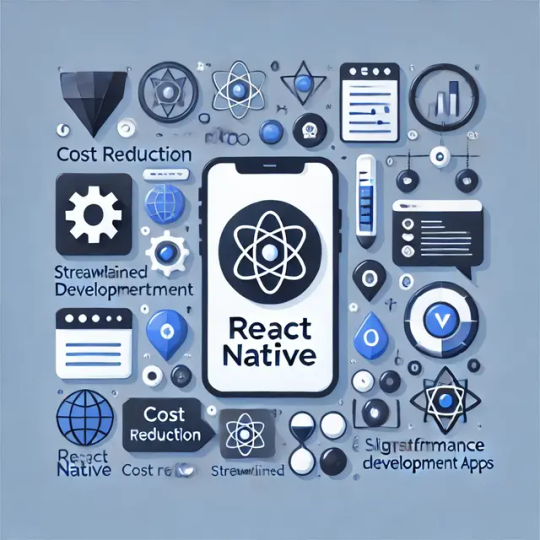#react native mobile app development
Explore tagged Tumblr posts
Text

Are you planning to convert your Android to iOS app using React Native? If Yes, then this guide will help you. Nowadays, React Native has become the ultimate solution for businesses who want to build a mobile app. One thing that makes react native most popular for developers is that developers can write code once and build an app for both Android and iOS and don’t need to write separate code for each OS.
#ios app development company#ios app development services#ios app developer#cross-platform app development#android to ios app#react native mobile app development#android app development company
1 note
·
View note
Text
Discover the Power of React Native Application Development Services

React Native is revolutionizing mobile app development with its efficient and powerful framework. Leverage React Native application development services to streamline your app development process, reduce costs, and deliver high-performance mobile applications.
#reactnative#businessgrowth#solutions#services#developer#reactjs#react native#react native development#customsolutions#react native app development company#react native app development services#react native application development#react native developers#react native mobile app development#technology#technews
0 notes
Text

Cost Associated With React Native Mobile App Development | Resourcifi
React Native mobile app development is a modern approach to building mobile applications that allows developers to use a single codebase for both iOS and Android platforms. Developed by Facebook, React Native leverages JavaScript and the React framework, enabling developers to create rich, high-performance apps with a native look and feel.
The cost of React Native mobile app development hinges on several key factors:
App Complexity
Design Complexity
Development Time
Third-Party Integrations
Testing and Quality Assurance
Maintenance and Support
0 notes
Text
#digital aptech#mobile app development#android app development#react native#ios app development#developer#app developers#app development#app developing company#react native app development services#react native mobile app development#react native developers#reactnativeappdevelopmentcompany#reactnativedevelopment
0 notes
Text
Birdmorning Solutions is a leading React Native app development company delivering app solutions. We provide world-class react native development services.
#react native#android app development#react native app development company#react native developer#react native mobile app development#react native app development services#react native services#react native app development#it services#development#app development#mobile app development#software development#app development company#android app#app developers#birdmorning
1 note
·
View note
Text
React Native: Rising Star of Mobile App Development
I. Market Analysis:
The mobile app development market is currently in a state of rapid evolution, with cross-platform solutions gaining significant traction. Among these, React Native stands out as a popular choice, with its demand seeing a significant upswing. A recent statistic, dubbed the “Hypergrowth Hero”, indicates that React Native’s adoption may soon surpass that of traditional languages like Swift or Kotlin for app development, signaling a shift in the mobile app development landscape.
Hypergrowth in React Native industry
Hypergrowth refers to the rapid expansion in the adoption or usage of a particular technology. In the context of React Native, it means that more and more developers and companies are choosing React Native for their mobile app development needs. This could be due to various reasons such as the ability to write one codebase for multiple platforms (iOS, Android), faster development times, and the strong support from the developer community.
II. Opportunities:
React Native offers several advantages that make it an attractive option for mobile app development. Beyond mobile, React Native also holds potential for developing applications for desktops, web apps, and even smart TVs. Furthermore, React Native opens up exciting possibilities for integrating cutting-edge technologies like ARCore, VR, and AI. Its code reusability feature allows developers to build applications for both iOS and Android platforms using a single codebase, leading to cost-effectiveness and speed to market. The “Hot Reloading Hero” feature enables developers to see the changes in their application in real-time without having to recompile it, significantly boosting developer productivity.
Hot Reloading feature of React Native:
Hot Reloading is a feature in React Native that allows developers to see the changes they make to the code in real-time, without needing to recompile the entire application. This can significantly speed up the development process, as developers can instantly view the impact of their changes and fix any issues immediately. It’s one of the features that make React Native popular among developers.
III. Challenges:
Despite its numerous advantages, React Native is not without its challenges. One of the primary issues is the “Talent Gap” - the demand for skilled React Native developers often outpaces the supply, impacting hiring and project costs. Other potential challenges include keeping up with the framework’s rapid updates and ensuring native-like performance across all platforms.
Talent Gap:
The Talent Gap refers to the shortage of skilled professionals in a particular field. In the context of React Native, it means that the demand for skilled React Native developers is higher than the supply. This can pose a challenge for companies looking to hire React Native developers, as the shortage can lead to increased competition, higher salaries, and longer hiring times. It can also impact project timelines and costs. This is a common challenge in fast-growing and rapidly evolving fields like mobile app development.
IV. Conclusion:
React Native offers a host of opportunities for mobile app development, from code reusability and cost-effectiveness to integration with advanced technologies. However, it’s important to be aware of the challenges, such as the talent gap and the need to ensure native-like performance.
V. The Future is Bright:
Looking ahead, the future of React Native in the mobile app development market appears bright. The technology continues to evolve, and with strong community support, it’s poised to meet the dynamic needs of the market. As a react native mobile app development company, we encourage you to explore React Native and unlock its potential for your next app project. The rise of React Native signifies a shift in the mobile app development landscape, making react native mobile app development a compelling option for businesses seeking to create innovative and efficient apps…
0 notes
Text
#React Native App Development Company#Data security in React Native#React Native mobile App Development
0 notes
Text

With React Native for the web, developers need to write a single React Native App that can run like a native app on Android and iOS. Moreover, with the help of standard web technologies, it can also be utilize on a web browser.
#React Native#React Native Development#react native development agency#react native mobile app development#mobile app development#web app development#web application development
1 note
·
View note
Text
React Native Best Practices

What Does it Mean by Best Practices?
It goes in the coding world — there are no strict rules, but some guidelines (more like suggestions) that many coders tend to avoid while writing code. When you’re first starting out, it can be tempting to skip over coding guidelines. After all, your code might work just fine without them. But as your codebase grows bigger, you’ll start to realize that adhering to guidelines is essential for keeping your code healthy and maintainable.
There are several benefits that we have discussed in our Java blog; you can read our blog about the benefits of clean code and best practices.

1. Use TypeScript with Your React Native App
TypeScript is a statically typed programming language which means it requires explicitly defining the data types for variables, functions, and other elements. This not only leads to more reliable code but also helps developers catch bugs during the compilation process.
Consider the following to calculate order pricefunction calculateOrderPrice(order) { return order.price + 1200; }
The current code works fine, but it doesn’t tell us much about what properties the order object contains, which could lead further to a crash if we try to access a property that doesn’t exist.
To prevent the crash and enhance readability, we can use TypeScript. TypeScript is a programming language that adds types to JavaScript. This means that we can specify the type of each property in the object, which will help us avoid errors.interface Order { price: number; name: string; taxPercentage: number; } function calculateOrderPrice(order: Order) { const { price, taxPercentage } = order; const taxValue = price * taxPercentage; return price + taxValue; }
Here is the same function, but now you and your editor are aware of the object properties and their types in code, which makes it easier to extend the functionality.
2. Functional Components over the Class Components
In React Native, you will have two main components: Functional and Class components. But functional components are the way to go in React Native. They’re simpler, more concise, and faster than class components. This makes them easier to read, write, and test. Plus, they can improve your app’s performance.
If you’re not sure what components are, they’re functions that return React elements. So if you’re looking for a way to improve your React Native code, use functional components over class components. They’re the future of React Native development.
Class Component Exampleimport React, { Component } from 'react'; class ClassComponent extends Component { constructor(props) { super(props); this.state = { count: 0, }; } incrementCount = () => { this.setState({ count: this.state.count + 1 }); }; render() { return ( <View> <Text style={styles.h1}>Class Component</Text> <Text>Count: {this.state.count}</Text> <Button title='Increment' onPress={this.incrementCount}/> </View> ); } } export default ClassComponent;
In this class component example, we’re using the Component class from react to create a component. State is managed within the component’s constructor, and the render method defines the component’s UI.
Functional Component Exampleimport React, { useState } from 'react'; const FunctionalComponent = () => { const [count, setCount] = useState(0); const incrementCount = () => { setCount(count + 1); }; return ( <View> <Text style={styles.h1}>Functional Component</Text> <Text>Count: {count}</Text> <Button title='Increment' onPress={incrementCount}/> </View> ); }; export default FunctionalComponent;
In this functional component example, we’re using the useState hook from react to manage state. The component is defined as a simple JavaScript function that returns JSX to render the UI.
3. Import your dependencies in order
When you have a bunch of imports in one file, it could be a headache trying to find that one specific import you need if you have not organized your imports properly. Therefore it is essential to order imports in a consistent way.
At the same time, you should also ensure that the dependencies have a proper sequence of imports. If the order is not correct, it can affect how components behave and lead to bugs that are hard to find.
Here’s an example of how you can organize your imports:
External imports — react
Internal imports, like relative paths — ../button
In folder imports like ./styles.ts
The imports may be sorted alphabetically in every group
Every group must be divided by white space
import React from 'react'; import { TouchableOpacity, View } from 'react-native'; import { Button, Card } from '../components' import { MainLayout } from '../layouts' import { StyledCard } from './styles.ts'
You can use formatting tools like Eslint and Prettier to automate and enforce the correct import order to avoid such issues.
4. Use Path Alias to avoid long imports
Path aliases are a way to create shorter and more meaningful import paths in your code. This can be helpful when you have a deep or nested folder structure, and it can make your imports easier to read and understand.
For example, instead of writing a long import like this:import { IconButton } from '../../components/buttons'; import { CircleButton } from 'components/buttons'; OR import { CircleButton } from 'buttons';
Here’s how to use path aliases in both TypeScript and React Native to create shorter and more meaningful import paths in your code.
Here’s how to use path aliases in both TypeScript and React Native to create shorter and more meaningful import paths in your code.
Path Alias in TypeScript
Create or update the tsconfig.json file in your project if it doesn’t exist already.
Set the baseUrl to . , which represents the root of the directory. This sets the starting point for all path aliases.
Add path aliases to the paths object. In this example, we have two path aliases defined:
// tsconfig.json { "extends": "expo/tsconfig.base", "compilerOptions": { "strict": true, // Path alias config "baseUrl": ".", "paths": { // This needs to be mirrored in babel.config.js // Components is a directory with sub directories "components/*": ["src/components/*"], // We want to expose the exports of the buttons index file "buttons": ["src/components/buttons/index"] } } }
Now, TypeScript will be able to understand and parse the following imports:import { CircleButton } from "components/buttons" import { CircleButton } from "buttons"
2. React Native Path Alias
First, install the babel-plugin-module-resolver as a developer dependencyyarn add - dev babel-plugin-module-resolver npm install babel-plugin-module-resolver - save-dev
Now we can update the babel.config.js file to use the **module-resolver**plugin and point to our directories.**// babel.config.js** module.exports = function (api) { api.cache(true) return { presets: ["babel-preset-expo"], plugins: [ [ "module-resolver", { alias: { // This needs to be mirrored in tsconfig.json components: "./src/components", buttons: "./src/components/buttons", }, }, ], ], } }
Responsive style properties in React refer to the use of functions to create an adaptive user interface or a layout that adjusts to various screen sizes and orientations. Developing a responsive React Native app can be done in multiple ways, and one of them is by using react-native-normalize. This handy library offers functions that help you create responsive layouts effortlessly.
5. Implement Crash Analytics Tools
Crash analytics tools are like your magic tools that keep an eye on your app 24/7. They do real-time monitoring to help you identify crashes and errors. These tools analyze the crash data and give you the lowdown on what’s causing the chaos.
So, if you’re in the development process, and suddenly, the app crashes out of the blue. With the implementation of crash analytics, you can easily find the root causes of these crashes.
There are a bunch of awesome crash analytics tools out there, like Sentry, Firebase, Crashlytics, and more. They’re like your trusty companions, helping you debug and rescue your app from potential crashes.
Read more at https://www.brilworks.com/blog/react-native-best-practices/
#react native#reactnative#react native app development company#react native developers#react native mobile app development
0 notes
Text
#react native mobile app#react native mobile app development#react native for mobile development#react native apps#hire react native developer#react for web development
1 note
·
View note
Text

React Native is a native app development platform utilizing Javascript. It is an amalgamation of both native and reacts native development. It is a highly functional framework and a best-in-class javascript library to create an attractive user interface. Many companies, including Facebook, find it troublesome to deliver the best functionalities through the current native stack.
#mobile app development services#react native app development company#react native app development services#react native mobile app development#react native app development cost
0 notes
Text
Discover the power of React Native Mobile App Development, a versatile solution for cost-effective cross-platform projects.
React Native stands out as a versatile solution for mobile app development, offering cost-effective cross-platform development and rapid iteration capabilities. Its streamlined approach and extensive ecosystem make it an attractive choice for businesses aiming to deliver high-quality mobile experiences efficiently.
Overall, React Native continues to empower businesses to innovate and succeed in the competitive mobile app landscape, driving efficiency, creativity, and value for both developers and users alike.
To know more, visit our react native mobile app development guide.
#mobile app development#react native mobile app development#react native mobile app development guide
0 notes
Text
Embark on a journey to uncover the hidden gems of React Native mobile app development with our comprehensive guide. React Native, the powerful and versatile framework, has revolutionized the way we create mobile applications. In this detailed exploration, we delve deep into the secrets that make React Native a go-to choice for building cross-platform mobile apps.
0 notes
Text
Best React Native App Developers in Indore for Android & iOS Solutions
Looking for top React Native app developers in Indore to build high-quality mobile applications? Young Decade is your trusted partner for developing scalable, feature-rich, and high-performance Android & iOS solutions. With our expertise in React Native development, we create apps that offer a seamless user experience across both platforms while ensuring cost-effective development.

Why Choose Young Decade for React Native App Development?
✅ Cross-Platform Excellence – Develop once, run on both Android and iOS without compromising performance. ✅ Custom Mobile Solutions – We tailor apps to meet your specific business needs. ✅ Fast Development & Deployment – Reduce time-to-market with efficient coding and reusable components. ✅ Engaging UI/UX – Deliver visually stunning and interactive mobile experiences. ✅ Performance-Optimized Apps – Build applications that load fast and run smoothly.
At Young Decade, we focus on building secure, scalable, and business-driven mobile applications. Whether you need a startup MVP, an enterprise solution, or an eCommerce app, our expert React Native developers in Indore ensure cutting-edge development with the latest technologies.
Start Your React Native Project Today!
Partner with Young Decade for the best React Native app development services in Indore. Let’s build a powerful and efficient Android & iOS app that helps your business grow. Contact us now to get started! 🚀
#software development company#android app developers#app development company#best android app development company#software development#flutter app development company in Indore#react native app development company in indore#mobile app development company in Indore
2 notes
·
View notes
Text
#react native development agency#react native app development services#react mobile app development#react native application development company#react native app development#react native mobile app development
0 notes
Text
0 notes